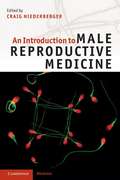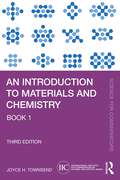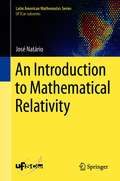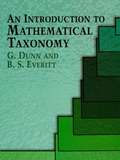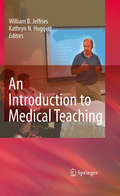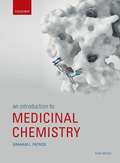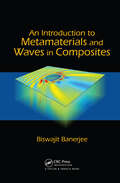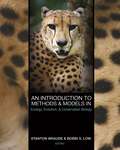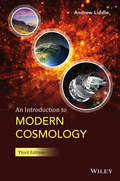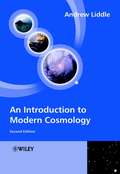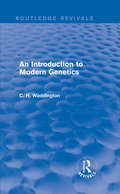- Table View
- List View
An Introduction to Macroscopic Quantum Phenomena and Quantum Dissipation
by Amir O. CaldeiraReviewing macroscopic quantum phenomena and quantum dissipation, from the phenomenology of magnetism and superconductivity to the presentation of alternative models for quantum dissipation, this book develops the basic material necessary to understand the quantum dynamics of macroscopic variables. Macroscopic quantum phenomena are presented through several examples in magnetism and superconductivity, developed from general phenomenological approaches to each area. Dissipation naturally plays an important role in these phenomena, and therefore semi-empirical models for quantum dissipation are introduced and applied to the study of a few important quantum mechanical effects. The book also discusses the relevance of macroscopic quantum phenomena to the control of meso- or nanoscopic devices, particularly those with potential applications in quantum computation or quantum information. It is ideal for graduate students and researchers.
An Introduction to Male Reproductive Medicine
by Craig NiederbergerAn Introduction to Male Reproductive Medicine is written specifically for readers seeking entry into this fast-moving, complex specialty with a solid understanding of the subject. The first chapters cover the anatomy and physiology, clinical evaluation, surgery, medicine, genetics and laboratory testing involved in the current evaluation and treatment of the infertile male, and the final chapter describes the interaction of the field with female reproductive medicine. Throughout the book, references are directly made to the fourth edition of the major text in the specialty, Infertility in the Male, edited by Larry Lipshultz, Stuart Howards and Craig Niederberger, allowing readers to expand their understanding of specific areas where desired. Each chapter is written by a well-renowned expert in an easy to follow, informal style, making the text ideal for students, residents and general physicians who are seeking to increase their general knowledge of the field.
An Introduction to Materials and Chemistry: Book 1 (Science for Conservators)
by Joyce H. TownsendThis new edition of An Introduction to Materials and Chemistry, book 1 in the updated Science for Conservators series, provides conservators and conservators-in-training with a very basic introduction to the language of chemistry and to the scientific approach. Drawing on 40 years of experience as a conservation scientist, Joyce H. Townsend takes readers through the elementary steps that will enable them to understand and investigate materials in historic objects, and those modern materials used to conserve them, in scientific terms. The book also introduces basic chemistry concepts. It provides worked examples and exercises throughout. This new edition has been significantly expanded and updated, with new material about health and safety, sustainability, and the trend to use greener materials, amongst other topics. The book also includes all-new illustrations, a list of further reading and is accompanied by a Companion Website, which features additional examples, illustrations and more. An Introduction to Materials and Chemistry assumes no previous scientific knowledge and will be essential reading for pre-program applicants to, and students already on, postgraduate conservation programs worldwide. It will also be useful to conservators who are looking to refresh their knowledge or to fill gaps in their training, and for those who trained in languages other than English, but now work in that language.
An Introduction to Mathematical Epidemiology (Texts in Applied Mathematics #61)
by Maia MartchevaThe book is a comprehensive, self-contained introduction to the mathematical modeling and analysis of infectious diseases. It includes model building, fitting to data, local and global analysis techniques. Various types of deterministic dynamical models are considered: ordinary differential equation models, delay-differential equation models, difference equation models, age-structured PDE models and diffusion models. It includes various techniques for the computation of the basic reproduction number as well as approaches to the epidemiological interpretation of the reproduction number. MATLAB code is included to facilitate the data fitting and the simulation with age-structured models.
An Introduction to Mathematical Population Dynamics: Along the trail of Volterra and Lotka (UNITEXT #79)
by Mimmo Iannelli Andrea PuglieseThis book is an introduction to mathematical biology for students with no experience in biology, but who have some mathematical background. The work is focused on population dynamics and ecology, following a tradition that goes back to Lotka and Volterra, and includes a part devoted to the spread of infectious diseases, a field where mathematical modeling is extremely popular. These themes are used as the area where to understand different types of mathematical modeling and the possible meaning of qualitative agreement of modeling with data. The book also includes a collections of problems designed to approach more advanced questions. This material has been used in the courses at the University of Trento, directed at students in their fourth year of studies in Mathematics. It can also be used as a reference as it provides up-to-date developments in several areas.
An Introduction to Mathematical Relativity (Latin American Mathematics Series)
by José NatárioThis concise textbook introduces the reader to advanced mathematical aspects of general relativity, covering topics like Penrose diagrams, causality theory, singularity theorems, the Cauchy problem for the Einstein equations, the positive mass theorem, and the laws of black hole thermodynamics. It emerged from lecture notes originally conceived for a one-semester course in Mathematical Relativity which has been taught at the Instituto Superior Técnico (University of Lisbon, Portugal) since 2010 to Masters and Doctorate students in Mathematics and Physics. Mostly self-contained, and mathematically rigorous, this book can be appealing to graduate students in Mathematics or Physics seeking specialization in general relativity, geometry or partial differential equations. Prerequisites include proficiency in differential geometry and the basic principles of relativity. Readers who are familiar with special relativity and have taken a course either in Riemannian geometry (for students of Mathematics) or in general relativity (for those in Physics) can benefit from this book.
An Introduction to Mathematical Taxonomy (Dover Books on Biology)
by B. S. Everitt G. DunnStudents of mathematical biology discover modern methods of taxonomy with this text, which introduces taxonomic characters, the measurement of similarity, and the analysis of principal components. Other topics include multidimensional scaling, cluster analysis, identification and assignment techniques, more. A familiarity with matrix algebra and elementary statistics are the sole prerequisites.
An Introduction to Mechanics
by Daniel Kleppner Robert J. KolenkowIn the years since it was first published in 1973 by McGraw-Hill, this classic introductory textbook has established itself as one of the best-known and most highly regarded descriptions of Newtonian mechanics. Intended for undergraduate students with foundation skills in mathematics and a deep interest in physics, it systematically lays out the principles of mechanics: vectors, Newton's laws, momentum, energy, rotational motion, angular momentum and noninertial systems, and includes chapters on central force motion, the harmonic oscillator, and relativity. Numerous worked examples demonstrate how the principles can be applied to a wide range of physical situations, and more than 600 figures illustrate methods for approaching physical problems. The book also contains over 200 challenging problems to help the student develop a strong understanding of the subject. Password-protected solutions are available for instructors at www.cambridge.org/9780521198219.
An Introduction to Medical Physics (Biological and Medical Physics, Biomedical Engineering)
by Muhammed MaqboolThis book begins with the basic terms and definitions and takes a student, step by step, through all areas of medical physics. The book covers radiation therapy, diagnostic radiology, dosimetry, radiation shielding, and nuclear medicine, all at a level suitable for undergraduates. This title not only describes the basics concepts of the field, but also emphasizes numerical and mathematical problems and examples. Students will find An Introduction to Medical Physics to be an indispensible resource in preparations for further graduate studies in the field.
An Introduction to Medical Teaching
by William B. Jeffries Kathryn HuggettFew faculty members in academic medical centres are formally prepared for their roles as teachers. This work is an introductory text designed to provide medical teachers with the core concepts of effective teaching practice and information about innovations for curriculum design, delivery, and assessment. It offers brief, focused chapters with content that is easily assimilated by the reader. Topics are relevant to basic science and clinical teachers, and the work does not presume readers possess prerequisite knowledge of education theory or instructional design. The authors emphasize application of concepts to teaching practice. Topics include: Helping Students Learn; Teaching Large Groups; Teaching in Small Groups; Problem Based Learning; Team-Based Learning, Teaching Clinical Skills; Teaching with Simulation; Teaching with Practicals and Labs; Teaching with Technological Tools; Designing a Course; Assessing Student Performance; Documenting the Trajectory of your Teaching and Teaching as Scholarship. Chapters were written by leaders in medical education and research who draw upon extensive professional experience and the literature on best practices in education. Although designed for teachers, the work reflects a learner-centred perspective and emphasizes outcomes for student learning. The book is accessible and visually interesting, and the work contains information that is current, but not time-sensitive. The work includes recommendations for additional reading and an appendix with resources for medical education.
An Introduction to Medicinal Chemistry
by Graham PatrickFor many people, taking some form of medication is part of everyday life, whether for mild or severe illness, acute or chronic disease, to target infection or to relieve pain. However for most it remains a mystery as to what happens once the drug has been taken into the body: how do the drugs actually work? Furthermore, by what processes are new drugs discovered and brought to market? <P><P>An Introduction to Medicinal Chemistry, sixth edition, provides an accessible and comprehensive account of this fascinating multidisciplinary field. Assuming little prior knowledge, the text is ideal for those studying the subject for the first time. Part one of the book introduces the principles of drug action via targets such as receptors and enzymes. The book goes on to explore how drugs work at the molecular level (pharmacodynamics), and the processes involved in ensuring a drug meets its target (pharmacokinetics). Further sections cover the processes by which drugs are discovered and designed, and what has to happen before a drug can be made available to the public. The book concludes with a selection of current topics in medicinal chemistry, and a discussion of various key drug groups. The subject is brought to life throughout by engaging case studies highlighting particular drugs and the stories behind their discovery and development. <P><P>The Online Resource Centre features: <P><P>For students: <br>DT Multiple Choice Questions to support self-directed learning <br>DT Web articles describing recent developments in the field and further information on topics covered in the book <br>DT Journal Club to encourage students to critically analyse the research literature <br>DT Molecular Modelling Exercises, with new exercises in Chem3D <br>DT New assignments to help students develop data analysis and problem solving skills <P><P>For registered adopters of the book: <br>DT A test bank of additional multiple-choice questions, with links to relevant sections in the book <br>DT Answers to end-of-chapter questions. <br>DT Figures from the book, ready to download. <br>DT Power Point slides to accompany every chapter in the book.
An Introduction to Metallurgy, Second Edition
by Sir Alan CottrellThis classic textbook has been reprinted by The Institute of Materials to provide undergraduates with a broad overview of metallurgy from atomic theory, thermodynamics, reaction kinetics and crystal physics, to elasticity and plasticity.
An Introduction to Metamaterials and Nanophotonics
by Constantin Simovski Sergei TretyakovMetamaterials have established themselves as one of the most important topics in physics and engineering, and have found practical application across a wide variety of fields including photonics, condensed matter physics, materials science, and biological and medical physics. This modern and self-contained text delivers a pedagogical treatment of the topic, rooted within the fundamental principles of nanophotonics. A detailed and unified description of metamaterials and metasurfaces is developed, beginning with photonic crystals and their underlying electromagnetic properties before introducing plasmonic effects and key metamaterial configurations. Recent developments in research are also presented along with cutting-edge applications in the field. This advanced textbook will be invaluable to students and researchers working in the fields of optics and nanophotonics.
An Introduction to Metamaterials and Waves in Composites
by Biswajit BanerjeeRequiring no advanced knowledge of wave propagation, An Introduction to Metamaterials and Waves in Composites focuses on theoretical aspects of metamaterials, periodic composites, and layered composites. The book gives novices a platform from which they can start exploring the subject in more detail.After introducing concepts related to elasticity,
An Introduction to Metametaphysics
by Tuomas E. TahkoHow do we come to know metaphysical truths? How does metaphysical inquiry work? Are metaphysical debates substantial? These are the questions which characterize metametaphysics. This book, the first systematic student introduction dedicated to metametaphysics, discusses the nature of metaphysics - its methodology, epistemology, ontology and our access to metaphysical knowledge. It provides students with a firm grounding in the basics of metametaphysics, covering a broad range of topics in metaontology such as existence, quantification, ontological commitment and ontological realism. Contemporary views are discussed along with those of Quine, Carnap and Meinong. Going beyond the metaontological debate, thorough treatment is given to novel topics in metametaphysics, including grounding, ontological dependence, fundamentality, modal epistemology, intuitions, thought experiments and the relationship between metaphysics and science. The book will be an essential resource for those studying advanced metaphysics, philosophical methodology, metametaphysics, epistemology and the philosophy of science.
An Introduction to Methods and Models in Ecology, Evolution, and Conservation Biology
by Stanton Braude and Bobbi S. LowAn innovative introduction to ecology and evolutionThis unique textbook introduces undergraduate students to quantitative models and methods in ecology, behavioral ecology, evolutionary biology, and conservation. It explores the core concepts shared by these related fields using tools and practical skills such as experimental design, generating phylogenies, basic statistical inference, and persuasive grant writing. And contributors use examples from their own cutting-edge research, providing diverse views to engage students and broaden their understanding.This is the only textbook on the subject featuring a collaborative "active learning" approach that emphasizes hands-on learning. Every chapter has exercises that enable students to work directly with the material at their own pace and in small groups. Each problem includes data presented in a rich array of formats, which students use to answer questions that illustrate patterns, principles, and methods. Topics range from Hardy-Weinberg equilibrium and population effective size to optimal foraging and indices of biodiversity. The book also includes a comprehensive glossary.In addition to the editors, the contributors are James Beck, Cawas Behram Engineer, John Gaskin, Luke Harmon, Jon Hess, Jason Kolbe, Kenneth H. Kozak, Robert J. Robertson, Emily Silverman, Beth Sparks-Jackson, and Anton Weisstein.Provides experience with hypothesis testing, experimental design, and scientific reasoningCovers core quantitative models and methods in ecology, behavioral ecology, evolutionary biology, and conservationTurns "discussion sections" into "thinking labs"Professors: A supplementary Instructor's Manual is available for this book. It is restricted to teachers using the text in courses. For information on how to obtain a copy, refer to: http://press.princeton.edu/class_use/solutions.html
An Introduction to Microscopy
by Suzanne Bell Keith MorrisMicroscopy, which has served as a fundamental scientific technique for centuries, remains an invaluable tool in chemistry, biology, healthcare, and forensics. Increasingly, it is being integrated into modern chemical instrumentation and is of value as a powerful analytical tool across many scientific disciplines. Designed to serve as a primary reso
An Introduction to Model-Based Cognitive Neuroscience
by Birte U. Forstmann Brandon M. TurnerThe main goal of this edited collection is to promote the integration of cognitive modeling and cognitive neuroscience. Experts in the field provide tutorial-style chapters that explain particular techniques and highlight their usefulness through concrete examples and numerous case studies. The book also includes a thorough list of references pointing the reader toward additional literature and online resources. The second edition of Introduction to Model-Based Cognitive Neuroscience explores important new advances in the field including joint modeling and applications in areas such as computational psychiatry, neurodegenerative diseases, and social decision-making.
An Introduction to Modern Cosmology
by Andrew LiddleA concise, accessible introduction to this exciting and dynamic subject.* Adopts an approach grounded in physics rather than mathematics.* Includes worked examples and student problems, along with hints for solving them and the numerical answers.* Many reviewers have commented that this is one of the best 'introductory undergraduate level' texts on the subject and they would all welcome a Second Edition.
An Introduction to Modern Cosmology
by Andrew LiddleAn Introduction to Modern Cosmology Third Edition is an accessible account of modern cosmological ideas. The Big Bang Cosmology is explored, looking at its observational successes in explaining the expansion of the Universe, the existence and properties of the cosmic microwave background, and the origin of light elements in the universe. Properties of the very early Universe are also covered, including the motivation for a rapid period of expansion known as cosmological inflation. The third edition brings this established undergraduate textbook up-to-date with the rapidly evolving observational situation. This fully revised edition of a bestseller takes an approach which is grounded in physics with a logical flow of chapters leading the reader from basic ideas of the expansion described by the Friedman equations to some of the more advanced ideas about the early universe. It also incorporates up-to-date results from the Planck mission, which imaged the anisotropies of the Cosmic Microwave Background radiation over the whole sky. The Advanced Topic sections present subjects with more detailed mathematical approaches to give greater depth to discussions. Student problems with hints for solving them and numerical answers are embedded in the chapters to facilitate the reader’s understanding and learning. Cosmology is now part of the core in many degree programs. This current, clear and concise introductory text is relevant to a wide range of astronomy programs worldwide and is essential reading for undergraduates and Masters students, as well as anyone starting research in cosmology.
An Introduction to Modern Genetics (Routledge Revivals: Selected Works of C. H. Waddington)
by C. H. WaddingtonFirst published in 1939 (second impression in 1950), this book provides an account of the changes in, and main principles of, genetics at that time. These are illustrated by references to the most authoritative and then recent investigations. Special attention is paid to the way in which genetics overlaps with other fields of inquiry, since it is often in these border-line subjects that the most important advances are to be expected. The book is particularly arranged to suit the convenience of students whose previous knowledge of genetics is small, and contains annotated bibliographies of suggestions for further reading.
An Introduction to Molecular Anthropology
by Mark StonekingMolecular anthropology uses molecular genetic methods to address questions and issues of anthropological interest. More specifically, molecular anthropology is concerned with genetic evidence concerning human origins, migrations, and population relationships, including related topics such as the role of recent natural selection in human population differentiation, or the impact of particular social systems on patterns of human genetic variation. Organized into three major sections, An Introduction to Molecular Anthropology first covers the basics of genetics - what genes are, what they do, and how they do it - as well as how genes behave in populations and how evolution influences them. The following section provides an overview of the different kinds of genetic variation in humans, and how this variation is analyzed and used to make evolutionary inferences. The third section concludes with a presentation of the current state of genetic evidence for human origins, the spread of humans around the world, the role of selection and adaptation in human evolution, and the impact of culture on human genetic variation. A final, concluding chapter discusses various aspects of molecular anthropology in the genomics era, including personal ancestry testing and personal genomics. An Introduction to Molecular Anthropology is an invaluable resource for students studying human evolution, biological anthropology, or molecular anthropology, as well as a reference for anthropologists and anyone else interested in the genetic history of humans.
An Introduction to Molecular Anthropology
by Mark StonekingA freshly updated discussion of the foundations of—and latest developments in—molecular anthropology In the newly revised second edition of An Introduction to Molecular Anthropology, retired researcher Dr. Mark Stoneking delivers an essential primer on genetics and molecular anthropology. The book is an accessible resource that covers key recent developments in the production and analysis of genome-wide data that highlights advances in methods and technologies, as well as the latest findings from ancient DNA. The updated chapters build on basic genetics and evolutionary concepts to demonstrate how to make inferences about human population history and human evolution in the genomics age. It explores how evolution influences genes, how genes evolve, the different kinds of genetic variation in humans and how they are analyzed, and the latest technologies and ethical issues that arise from the sampling of modern populations. Readers will also find: A thorough introduction to the genetic evidence of human origins and the spread of humans around the worldComprehensive explorations of the role of selection and adaptation in human evolutionPractical discussions of the impact of culture on human genetic variationComplete treatments of likely future developments within molecular anthropology in the genomics era Perfect for anthropology students and others studying introductory human evolution, An Introduction to Molecular Anthropology will also benefit practicing anthropologists and researchers in a variety of fields that touch on this topic.
An Introduction to Molecular Biology
by 0 R.C. Tait,This book explains molecular biology concepts clearly and in practical terms. It represents an invaluable introduction to molecular biology for undergraduates, postgraduates, researchers, lecturers, medics, nurses, teachers, scientists, editors, and all t
An Introduction to Molecular Biotechnology: Fundamentals, Methods and Applications
by Michael WinkMolecular biotechnology continues to triumph, as this textbook testifies - edited by one of the academic pioneers in the field and written by experienced professionals. This completely revised second edition covers the entire spectrum, from the fundamentals of molecular and cell biology, via an overview of standard methods and technologies, the application of the various "-omics", and the development of novel drug targets, right up to the significance of system biology in biotechnology. The whole is rounded off by an introduction to industrial biotechnology as well as chapters on company foundation, patent law and marketing. The new edition features: - Large format and full color throughout - Proven structure according to basics, methods, main topics and economic perspectives - New sections on system biology, RNA interference, microscopic techniques, high throughput sequencing, laser applications, biocatalysis, current biomedical applications and drug approval - Optimized teaching with learning targets, a glossary containing around 800 entries, over 500 important abbreviations and further reading. The only resource for those who are seriously interested in the topic. Bonus material available online free of charge: www.wiley-vch.de/home/molecbiotech

